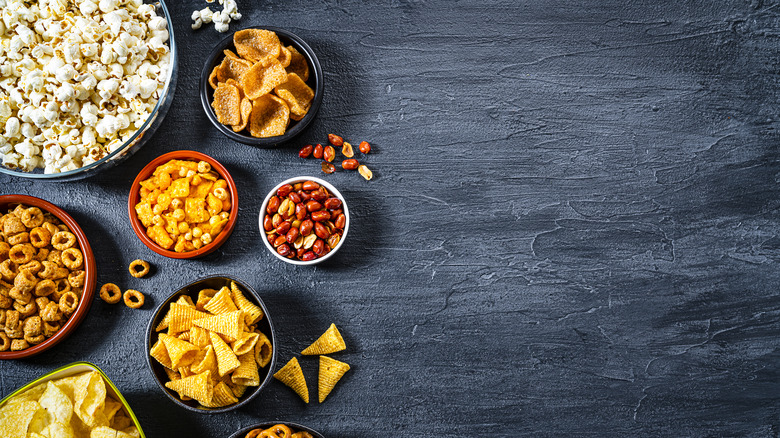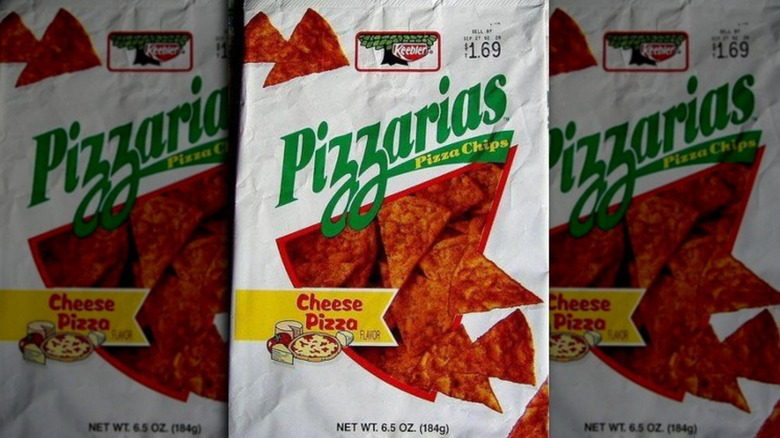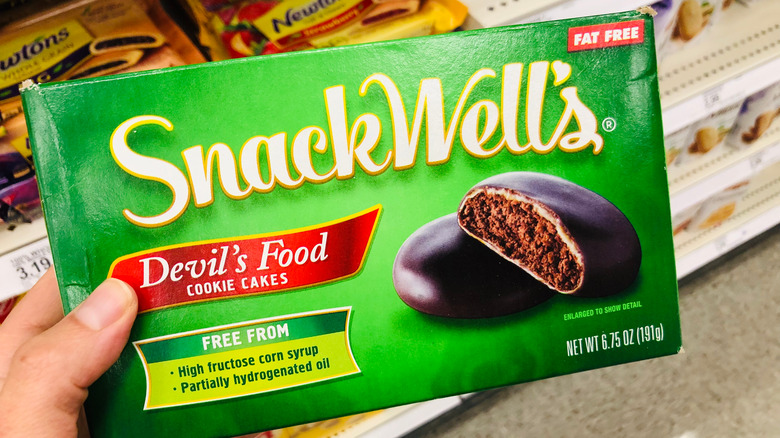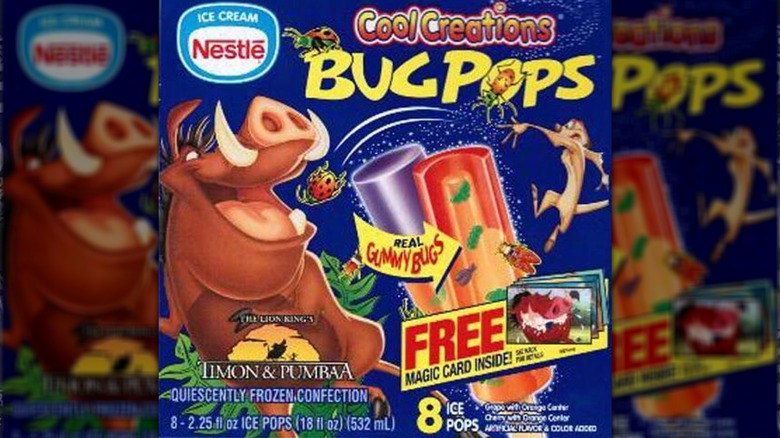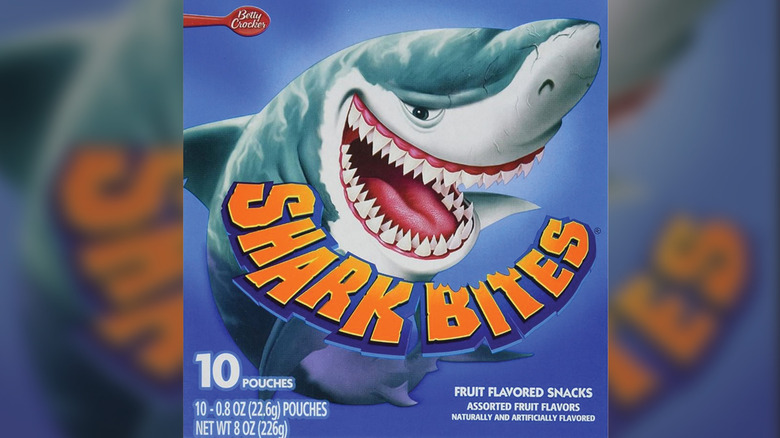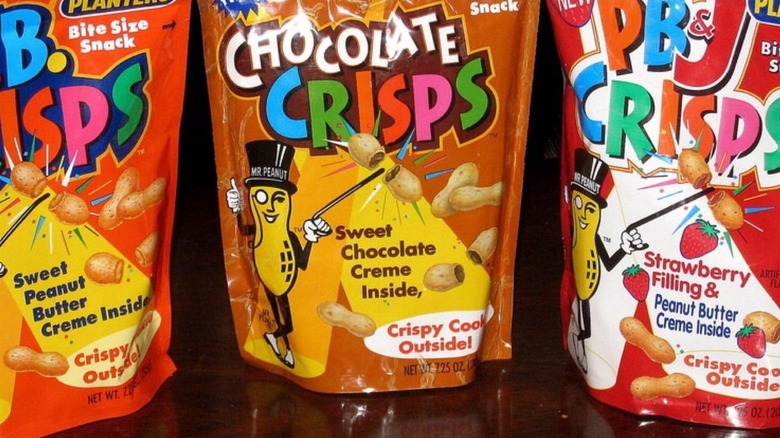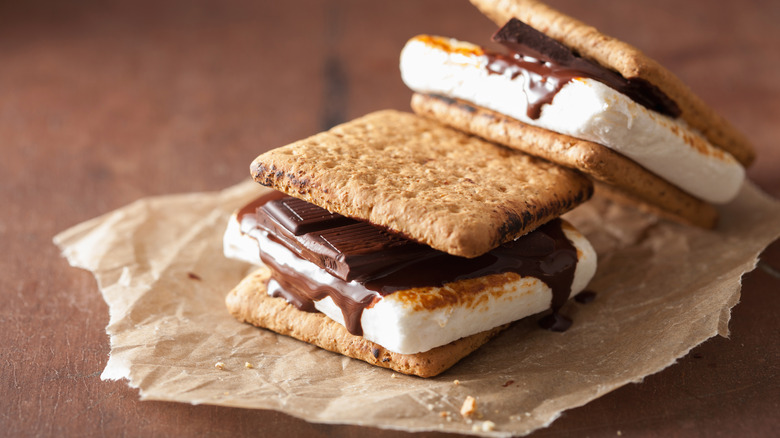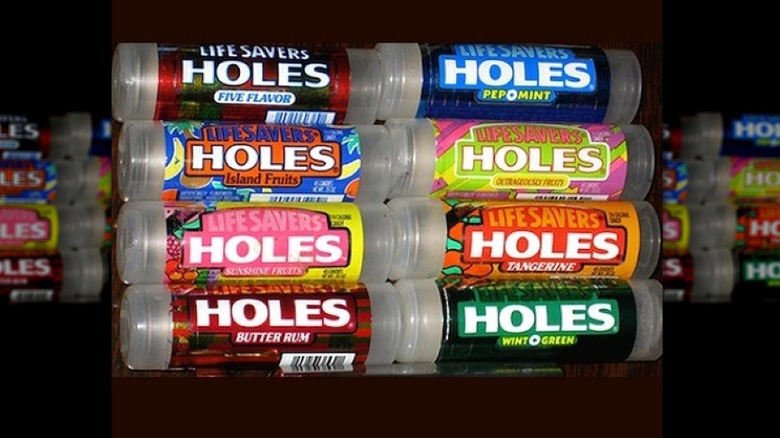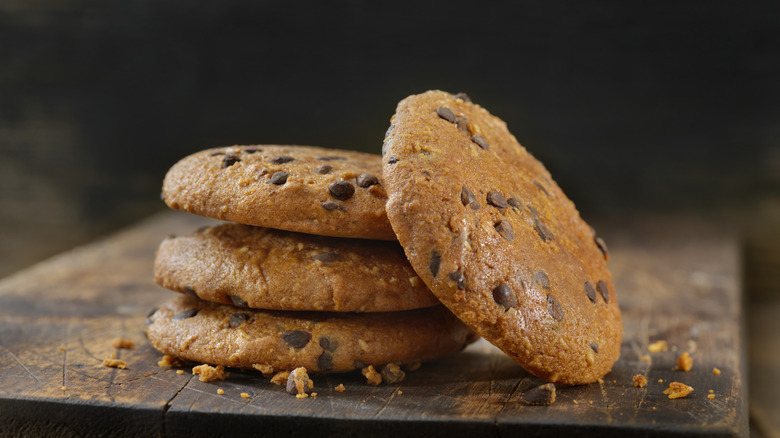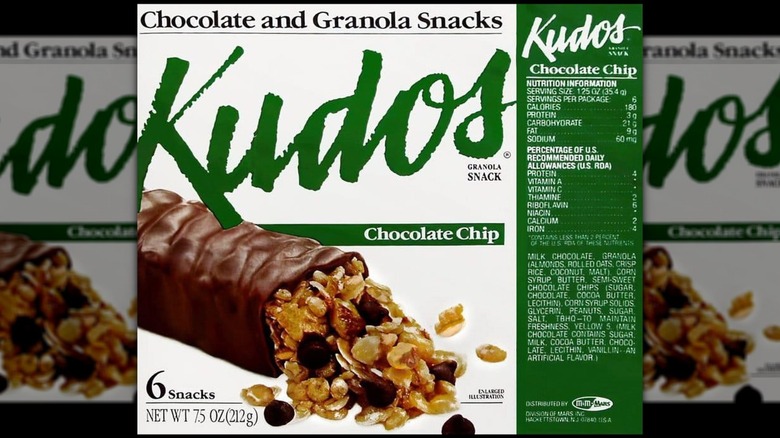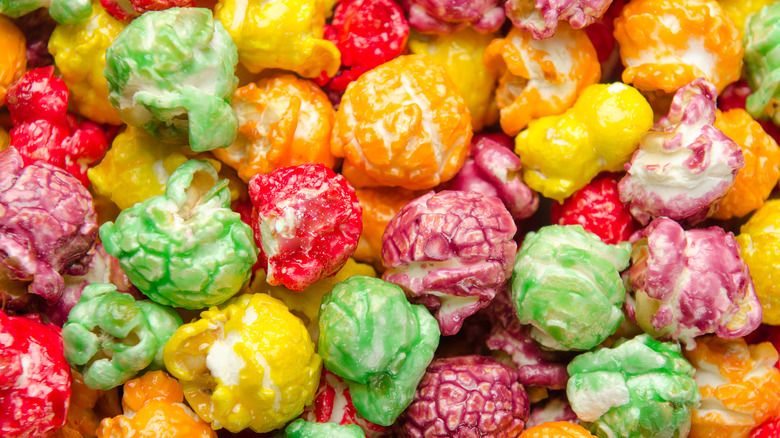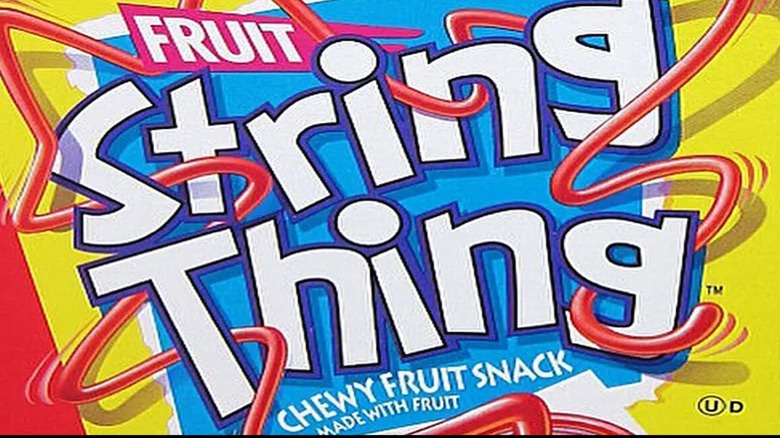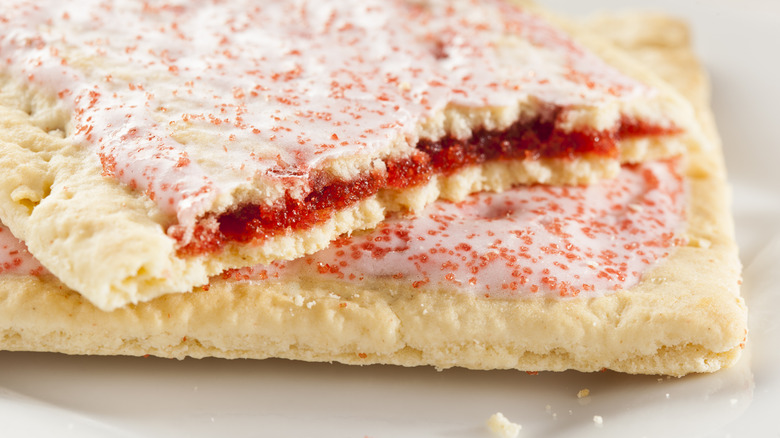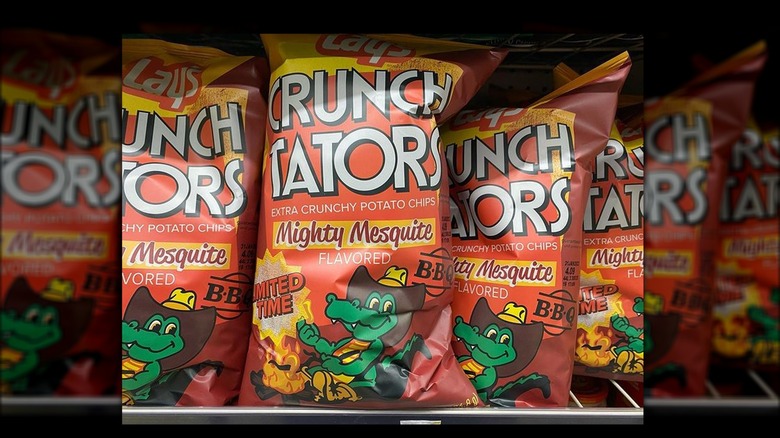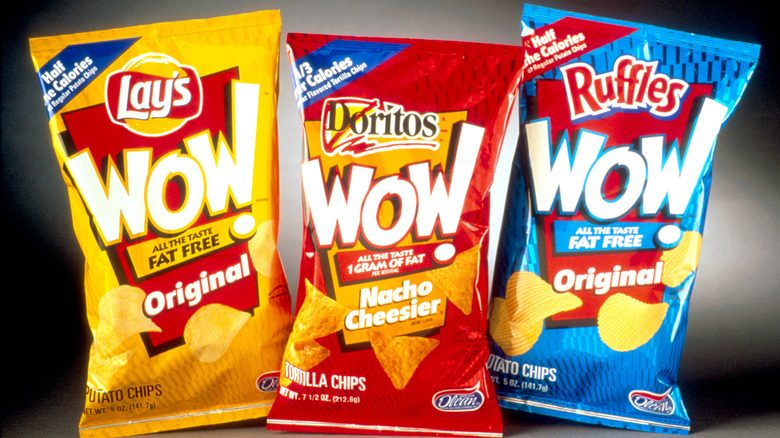14 1990s Discontinued Snacks That You Probably Forgot Existed
The 1990s gave the world many gifts, from frosted tips and slap bracelets to dial-up internet and the Macarena. Nothing conjures feelings of nostalgia for this era quite like the snack foods that sustained us through the decade. The '90s was a booming time for processed snacks as production became less expensive and consumer demand for cheap, convenient, kid-friendly foods grew. It was an era when kids subsisted on Lunchables, yogurt squeeze tubes, and Bugles and — according to all the '90s nostalgia posts splashed across social media — loved it.
The human brain is hardwired to remember the foods we eat and the contexts in which we eat them. That's why the smell of a freshly unwrapped Fruit Roll-Up has the ability to transport you back to your elementary school cafeteria, and the taste of a cherry Ring-Pop triggers feelings of nostalgia for childhood. In the age of social media, the collective nostalgia for discontinued '90s-era snacks has been powerful enough to incentivize some brands to bring back a few discontinued favorites from that decade.
In 2020 Dunkaroos made a triumphant comeback to store shelves and Creme Savers weren't far behind. Meanwhile, other equally beloved snack foods, like the sticky strands of Fruit String Thing and the salty crunch of PB Crisps, have been lost to the quick-moving sands of time. So, pop your Pearl Jam tape into the cassette deck and start reminiscing about 14 snacks from the 1990s that no one seems to talk about anymore.
1. Keebler's Pizzarias
Pizzarias were crunchy chips with the shape and texture of a tortilla chip and all the cheesy flavor of a classic pizza slice. They were made from pizza dough that gave the chips a distinct texture and quality and were coated with a Dorito-like cheese powder that stuck to your fingers as you snacked. Introduced in 1991, the pizza-inspired line of snacks included three flavor options: original, supreme, and zesty pepperoni.
Keebler was far from the first major food company to try to capitalize on America's love affair with pizza. Other brands such as Pringles and General Mills have attempted to capture the flavor of a cheesy slice in snack food form but they just weren't the same as the Pizzarias. If you're craving the cheesy crunch of a Pizzaria chip today, you're out of luck. Despite the initial massive success of the Pizzarias line, by the late '90s, they were no longer after Keebler was bought out.
2. SnackWell's Devil's Food Cookies
In the 1990s, low-fat diets were king of the weight loss industry. Right on cue, SnackWell's burst onto the scene with fat-free Devil's Food Cookie Cakes, promising we could have our cake and slim down, too. The signature bright green boxes of SnackWell's cookies were a staple in diet-conscious pantries throughout the '90s. The light chocolate cake rounds had a thin layer of marshmallow creme covered in a thin chocolatey coating. Most importantly to some, these cookies contained not a single gram of fat in their original incarnation.
The Devil's Food-inspired fat-free treats weren't the only product pedaled by SnackWell's, but they were by far the most popular. Between 1993 and 1996, the SnackWell's sold about $161 million worth of Devil's Food Cookie Cakes. Whether the massive success was due to the quality of the product or its branding as a nutritionally superior choice to other processed cookies, is up for debate. As diet trends shifted away from the low-fat preferences of '90s consumers, SnackWell's struggled to keep up with changing consumer preferences. After years of decline, Snackwell's ended all business operations in 2022.
3. Nestle's Cool Creations Bug Pops
Disney tie-in products were all the rage in the '90s. Corporations caught on quickly that slapping a popular cartoon character onto kids' snack foods was an easy way to yield major sales. Bug Pops were created by Nestle as a promotional tie-in for the Disney Channel show "Timon and Pumbaa", a TV spin-off of 1994's blockbuster film "The Lion King." Inside each fruity frozen ice pop was an array of gummy "bugs", shaped like the creepy crawly creatures eaten by Timon and Pumbaa in the show.
Like other novelty desserts of the 1990s, Bug Pops were unapologetically artificial. A 1997 review in The Standard-Times criticized the product for the abundance of artificial flavors and colors and "lack of vitamins and minerals". Kids, on the other hand, just focused on the joy of pretending to eat insects for dessert. Ultimately, Cool Creations phased out Bug Pops as the mania for all things "Lion King" faded in the late '90s. Now if you want gummy worms in your popsicle, you'll have to add them yourself.
4. Betty Crocker's Shark Bites Fruit Snacks
Shark Bites hit all the markers of a great '90s nostalgia snack: novelty shape, brightly colored packaging, and a transformation to a nearly unrecognizable product by the dawn of the new millennium. These shark-shaped gummies hit shelves in 1988 and peaked in the early 1990s when commercials for the shark-shaped gummies framed the General Mills product as a more exciting alternative to the average fruit snack.
Made by Betty Crocker, Shark Bites had a similar taste and texture to the popular '80s snack Fruit Wrinkles, but with an edgier twist. Part of the thrill of eating Shark Bites was the hunt for the elusive single Great White-shaped gummy in every package. At one point, Shark Bites came with a few special pieces of shark teeth in the package. "Just when you thought it was safe to eat Shark Bites," one commercial teased before revealing the new pointy white shapes.
Betty Crocker still sells Shark Bites, but the current product bears little resemblance in taste or appearance to its '90s predecessor. You won't find any chalky white or tooth-shaped pieces in the version on shelves today, making some fans of the original fruit snack wonder: What's even the point?
5. Planter's PB Crisps
From its monocled mascot, Mr. Peanut, to its signature roasted nuts, Planters is a brand associated with all things nutty. Back in 1992, the company expanded its snack food offerings to include P.B. Crisps. These crunchy treats were like peanut-shaped wafer cookies filled with smooth peanut butter cream. If you wanted more sweetness in your bite-sized snack, P.B. Crisps were also available in chocolate creme and peanut butter and jelly flavors. All three flavors sold modestly in the mid-1990s, disappearing from shelves just a few years after their release.
Decades later, P.B. Crisps fans are still craving the unique combination of crispy wafer and nutty cream. Various campaigns and petitions have popped up on the internet in recent years, hoping the convince Planters to revive the long-gone '90s snack, but to no avail. Planters revealed in a 2017 tweet that P.B. Crisps didn't sell as well as the current internet hype would have you believe and that the company revealed no plans to give them a second chance in the 21st century.
6. Nabisco's Suddenly S'mores
Nabisco's Suddenly S'mores brought the magic of a campfire classic to your microwave. Suddenly S'mores featured two fudge-dipped graham cookies sandwich with dehydrated marshmallows. You could eat the cookies straight from the package, if you didn't mind the hard and dry marshmallow, but the real magic of Suddenly S'mores happened when you zapped them in the microwave. In just 25 seconds, the marshmallows puffed up and softened into the fudge layer creating an ooey-gooey campfire quality s'mores experience — no nature required. In the early '90s, when microwave ovens were a relatively new fixture in American households, the concept of a microwaveable s'more seemed downright innovative.
Novelty alone must not have been enough to keep Suddenly S'mores in demand. The cookie sandwiches didn't stick around long, disappearing from grocery store shelves around 1992. While you can make your own s'mores at home in the microwave, fans of the short-lived Nabisco product still pine for the distinct texture and fudgy marshmallow flavor of the early '90s snack.
7. Life Savers Holes
Everyone remembers Creme Savers as the signature Life Saver's product of the 1990s, but do you remember Life Saver's Holes? If you don't, you're not alone. The candy company best known for its ring-shaped mints and hard candies, announced the addition of "Holes" to its product line in 1990. Perhaps inspired by the popularity of donut holes, Life Saver's Holes were ball-shaped candies made from the center of fruity lifesavers.
The bite-sized candies were sold in plastic flip-top tubes, similar to the familiar tubes of M&M minis on shelves today. The packaging was designed to be portable and easy to fit into your pocket on the go, but it also proved to be a costly mistake. The soft narrow plastic tops ended up being just the right size for children to choke on accidentally. According to a report by the Chicago Tribune at the time, Life Saver's recalled Holes in January 1991, following reports that several children gagged on the packaging. In the wake of Holes' demise, the company shelved the concept and has yet to attempt a relaunch.
8. Frookies
If your parents were strict about sugar in the 1990s, you probably remember Frookies. These fruit-sweetened cookies were ahead of their time, a rare natural alternative to the corn syrup-laden packaged cookies most associated with the '90s. Available in a variety of flavors like vanilla creme and apple spice, the snacks helped bring natural foods into the mainstream. What once might have been dismissed as "hippie food" in the 1970s and 1980s was now being marketed as a fun, upbeat, and delicious product geared towards kids as much as their parents.
The boxes were sold in brightly colored packaging featuring a cheery curly-headed cartoon mascot that looked right at home in the cookie aisle of an early 1990s supermarket. In spite of the colorful and kid-oriented packaging the cookies inside still tasted distinctly "healthy." Nevertheless, any kind of cookie was better than no cookie and you'd take what you could get.
Frookies' creator Richard Worth created his first cookies in 1987 and achieved quick success. By 1994, the Frookies brand was worth $65 million and making plans to acquire snack giant Keebler Foods. The lightning-quick growth of the company turned out to be unsustainable and the Frookie brand dissolved by 1999. Today Frookies are remembered as one of the products that proved natural foods could be just as profitable as their sugar-laden counterparts.
9. Mars' Kudos Bars
Kudos bars were the '90s answer to the dry crumbly granola bars of previous decades. Created by candy giant Mars Incorporated, Kudos bars were advertised as a "granola snack" that tasted like a decadent dessert. The chocolate-dipped granola bars had a soft, chewy texture similar to Rice Krispies Treats with appealing mix-ins like chocolate chips and peanut butter. The original Kudos were essentially a glorified candy bar for adults, though the presence of oats in the bars made them seem like a far healthier choice. The 180-calorie original bars might not have been nutritionally dense, but they did have an avid fan base throughout the 1990s and well into the 2000s.
The Kudos Bars recipe experienced a few changes over the years. They also leaned heavily into the candy bar category with flavors featuring M&Ms, Dove, and Snickers candies. These last versions of Kudos contained more calcium and whole grains per serving than previous versions. But, Kudos bars disappeared from shelves unceremoniously as Mars made way to acquire KIND bars in 2019.
10. Pop Secret's Qwiz Pop
The neon color trend was real in the 1990s. It seemed every food brand decided it needed some kind of vibrantly pigmented snack to capture kids' attention. Pop Secret got on the colorful bandwagon early with Pop Qwiz, a microwave popcorn for kids that — you guessed it — came in a rainbow of colors. The catch? You didn't know what color you had until the kernels had popped.
The suspense of listening to your popcorn pop and wondering what color you'd get made Pop Qwiz more than a snack. It was an experience. Opening a steaming bag of popcorn to reveal whether you had red, yellow, green, or orange popcorn made the whole process of microwave popcorn feel like the main event of the evening. The "Qwiz" in the product's name is a reference to the trivia games printed on popcorn bags. Each bag included a trivia question, riddle, or puzzle to figure out while you munched away on handful after handful of buttered neon popcorn.
11. Betty Crocker's Fruit String Things
Fruit String Things gave us permission to play with our food. The snack consisted of long candy "strings" made with fruit pulp and sugar, similar in texture to gummy candies but even stickier. Manufactured by Betty Crocker from the early to mid-1990s, Fruit String Things offered a multi-sensory experience from start to finish. The long fruity laces came in berry blue, strawberry, and cherry flavors and were attached in spirals to a piece of wax paper.
You'd peel each fruit string off the paper and unwind them one by one. From there you'd either slurp them like spaghetti, arrange them into your own design, or just pop them right into your mouth. The process of playing with Fruit String Thing made your fingers delightfully sticky and gooey, which was all part of the fun. Betty Crocker stopped making Fruit String Thing in the early 2000s but its legacy lives on in products like Fruit by the Foot and other snack foods that encourage kids to get hands-on with their treats.
12. Kellogg's Pop-Tart Pastry Swirls
Pop-Tarts have dominated the toaster pastry category since their debut in 1964. In the late 1990s the packaged pastry brand added Pop-Tarts Pastry Swirls to its line-up of frosted breakfast snacks. Pastry Swirls were round, thick, and flaky, designed to mimic fresh-baked pastries from a bakery or coffee house. Unlike traditional Pop-Tarts, Pastry Swirls icing did not cover the entire top of the toaster pastry. This resulted in a less sugary taste with more emphasis on the fruit filling.
It's likely Pop-Tarts modeled their Pastry Swirls after Pillsbury Toaster Streudels, nearly identical product that launched in the 1980s. A 1994 advertising campaign for Toaster Strudels branded them as a superior alternative to Pop-Tarts with the catchphrase, "Something better just popped up." Pillsbury may have won over some consumers' tastebuds with their thicker, fruitier product, but Pop-Tarts fans seemed to prefer the original icing-saturated version. The company manufactured its last box of Pastry Swirls in 2001 and doesn't seem to have any intention of bringing them back.
13. Frito-Lay's Crunch Tators
Crunch Tators were among the first spicy chips to gain widespread distribution in the United States. Super crunchy with a mouth-burning fiery flavor, this Frito Lay product hit shelves in 1988 preceding the debut of "Flamin' Hot Cheetos" by three years. Crunch Tators came in two flavors, Hoppin' Jalapeño, and Mighty Mesquite, both spicier than any mainstream chips at the time. Bags of the Hoppin' Jalapeño Crunch Tators featured a cartoon gator shaking maracas. On Mighty Mesquite chip bags the grinning gator swapped his maracas for a campfire and a cowboy hat.
Frito Lay stopped making Crunch Tators in the early 1990s, but not before the spicy snacks got their moment in the spotlight. The 1990 film "Home Alone" shows a bag of mighty Mesquite Crunch Tators in one famous scene. The Frito-Lay label, bright red and yellow packaging, and gator mascot are clearly visible as the film's protagonist feasts on junk food while enjoying his new unsupervised life. Crunch Tators might not be as well remembered as other discontinued '90s treats, but their appearance in "Home Alone" has cemented their status in the proverbial retro snack hall of fame.
14. Frito-Lay's Wow Chips
Frito-Lay may have thought it hit the jackpot when it introduced its WOW line of potato chips to U.S. markets in 1998. The fat-free chips were fried in Olestra, a synthetic calorie-free fat branded as Olean, instead of the usual vegetable oil. Commercials for WOW boasted that Olean fried chips had none of the fat of traditional fried potato chips with all the familiar salty, crispy taste. Frito Lay released WOW versions of its Ruffles, Lays, and Doritos brands and collected a whopping $347 million in sales in the first year.
But, it didn't take long for consumer complaints to start pouring in. The wonder chips were found to cause digestive distress in many people, a direct side-effect of Olestra. According to a review by Lawson KD, Middleton SJ, and Hassall CD, Olestra can't be absorbed by the digestive system, it creates a laxative effect which can manifest as anything from mild cramping to severe diarrhea. In 2004, Frito-Lay did its best to save its fat-free chips by swapping the WOW label for "light", although it continued using Olean in its recipe. Frito Lay eventually discontinued its production of fat-free chips entirely. Unlike other iconic products of the 1990s, WOW chips are one snack no one wants to make a comeback.
